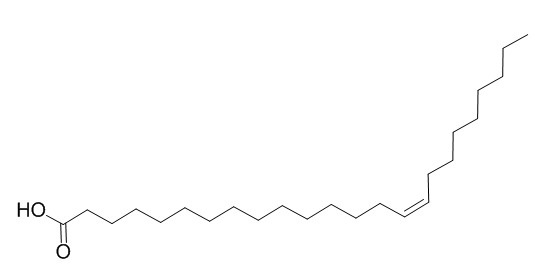Nervonic acid
Nervonic acid improves learning memory ability in normal mice and mice with experimental memory impairment. Nervonic acid can inhibit DNA polymerase beta and HIV-1 reverse transcriptase.
Inquire / Order:
manager@chemfaces.com
Technical Inquiries:
service@chemfaces.com
Tel:
+86-27-84237783
Fax:
+86-27-84254680
Address:
1 Building, No. 83, CheCheng Rd., Wuhan Economic and Technological Development Zone, Wuhan, Hubei 430056, PRC
Providing storage is as stated on the product vial and the vial is kept tightly sealed, the product can be stored for up to
24 months(2-8C).
Wherever possible, you should prepare and use solutions on the same day. However, if you need to make up stock solutions in advance, we recommend that you store the solution as aliquots in tightly sealed vials at -20C. Generally, these will be useable for up to two weeks. Before use, and prior to opening the vial we recommend that you allow your product to equilibrate to room temperature for at least 1 hour.
Need more advice on solubility, usage and handling? Please email to: service@chemfaces.com
The packaging of the product may have turned upside down during transportation, resulting in the natural compounds adhering to the neck or cap of the vial. take the vial out of its packaging and gently shake to let the compounds fall to the bottom of the vial. for liquid products, centrifuge at 200-500 RPM to gather the liquid at the bottom of the vial. try to avoid loss or contamination during handling.
Industrial Crops and Products2019, 140:111612
Phytother Res.2022, 10.1002:ptr.7602.
Food Chem.2022, 378:131975.
Exp Biol Med (Maywood).2019, 244(16):1463-1474
Plant Biotechnology Reports 2021, 15:117-124.
Nutrients.2023, 15(6):1335.
Molecules.2022, 27(19):6651.
Food Chem X.2024, 24:101909.
J Mass Spectrom.2022, 57(2):e4810.
Front Microbiol.2023, 14:1232039.
Related and Featured Products
The Experimental Biology. 2004.
Nervonic Acid improves learning memory ability in normal mice and mice with experimental memory impairment[Reference:
WebLink]
Nervonic acid (NA), a monounsaturated fatty acid (C24:1), is a component of membranes of the nervous system.
METHODS AND RESULTS:
We employed platform step-down (PSD) and water-maze swim (WMS) technologies and examined in this study the effects of NA in improving learning memory in 3 animal models: normal mice and mice with memory impairment. NA was given to mice at a dose of 12.3, 24.5, or 49.0 mg/kg by gavage. (1) In normal mice, 22 days of oral NA supplementation reduced the number of PSD mistakes (p=0.003) and extended the PSD latency (p=0.040). (2) After 30 days of oral NA or placebo, mice were given scopolamine (2 mg/kg, i.p.) at Day 30, to induce learning memory impairment. The number of PSD mistakes was reduced with NA (p<0.001). (3) Mice received oral NA for 35 days and i.p. scopolamine for 7 days (the 28th to 34th day). The number of dead-end mistakes in WMS test was reduced in NA-treated mice (p=0.025). A 90-day test revealed that oral NA caused increases in serum ALT and total cholesterol and decreases in blood glucose in rats.
CONCLUSIONS:
These results indicate that oral NA supplementation is effective on enhancing memory in both normal mice and mice with experimental memory impairment, but its toxicity may prohibit its use.
J Biochem. 2002 Nov;132(5):819-28.
Three-dimensional structural model analysis of the binding site of an inhibitor, nervonic acid, of both DNA polymerase beta and HIV-1 reverse transcriptase.[Pubmed:
12417034]
Previously, we reported the three-dimensional molecular interactions of Nervonic acid (NA) with mammalian DNA polymerase beta (pol beta) [Mizushina et al. (1998) J. Biol. Chem. 274, 25599-25607].
METHODS AND RESULTS:
By three-dimensional structural model analysis and comparison with the spatial positioning of specific amino acids binding to NA on pol beta (Leu11, Lys35, His51, and Thr79), we obtained supplementary information that allowed us to build a structural model of human immunodeficiency virus type-1 reverse transcriptase (HIV-1 RT). In HIV-1 RT, Leu100, Lys65, His235, and Thr386 corresponded to these four amino acid residues.
CONCLUSIONS:
These results suggested that the NA binding domains of pol beta and HIV-1 RT are three-dimensionally very similar. The effects of NA on HIV-1 RT are thought to be same as those on pol beta in binding to the rhombus of the four amino acid residues. NA dose-dependently inhibited the HIV-1 RT activity. For binding to pol beta, the kinetics were competitive when the rhombus was present on the DNA binding site. However, as the rhombus in HIV-1 RT was not present in the DNA binding site, the three-dimensional structure of the DNA binding site must be distorted, and subsequently the enzyme is inhibited non-competitively.



